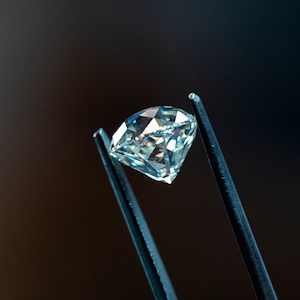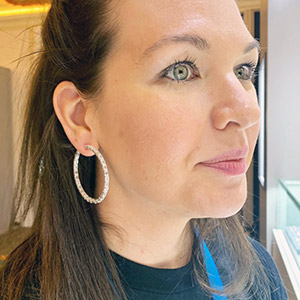
Having experienced various acquisitions and restructurings at places where I’ve worked, I have considerable sympathy for De Beers’ 20,000 employees as they digest the news that majority owner Anglo American plans to sell off their company. While big corporate changes sometimes work out for the best, they are rarely pleasant for those who live through them.
Prior to 2023, De Beers was enjoying a pretty strong run, but lately it’s experienced considerable turmoil, as sales have fallen and it looks to cut $100 million from its bottom line. A number of veterans have already left the company. I’ve heard the mood described as “anxious.” Whatever happens, the “money is no object” ethos that seemed to characterize most De Beers events and parties is probably a thing of the past.
Given Anglo’s long history with De Beers, many people in the industry were surprised by the announcement. But they probably shouldn’t have been, as sentimental ties mean little these days. Anglo—which owns 85% of De Beers—is clearly under pressure, with Australia’s BHP already making a takeover offer and other miners suggesting they may bid too. (BHP doesn’t seem that enthusiastic about the diamond business; it ditched its holdings in the sector back in 2012.) So Anglo has made a defensive move, announcing plans to divest its holdings in three troubled commodities—diamonds, platinum, and coal.
I can’t speak about coal, but it’s certainly possible that its platinum and diamond sales could recover. Platinum’s woes have little to do with jewelry, but rather have mostly been caused by the popularity of electrical vehicles, as Anglo executive Benn Oeyen explained to National Jeweler last week. Now that EV sales have apparently peaked, Oeyen believes platinum will be well positioned for the next iteration of automobiles—hydrogen fuel cell vehicles. He may be right, but at the moment the metal’s price is down and Anglo’s platinum operations are unprofitable, and that’s all Anglo cares about. So it’s cutting platinum loose.
Diamond sales could also stage a comeback. It wasn’t so long ago (the early to mid-2010s) that De Beers was Anglo’s golden child, possibly saving Anglo when it was experiencing a cyclical downturn. (The diamond industry has its own unique cycles—its “own weather,” I’ve heard it called.) And though it’s hard to make any long-term predictions about the diamond industry, especially with regard to lab-grown, the business has been through numerous crises (see here and here), and has always gotten out of them.
The problem is Anglo’s sale announcement has shaken trade confidence. Anglo may not want to sell De Beers at the bottom of the market, but damaged industry morale could make a recovery harder.
Still, an ownership change could ultimately benefit De Beers. “This uncoupling of the two companies gives us the ability to deploy and achieve our strategy in a way that we’ve never had before,” De Beers CEO Al Cook tells JCK. “I’m excited and I’m confident.”
Some company vets agree that De Beers may fare better spun off from Anglo.
“De Beers is not a proper mining company,” says one, speaking anonymously. “It will be better for De Beers to be outside Anglo because Anglo doesn’t know how to manage it properly. [Anglo CEO] Duncan Wanblad does not understand it and the diamond world. And what you don’t understand, you sell.”
But who will buy? There have been disconcerting reports that Gulf State sovereign-wealth funds may be interested, possibly because they see owning De Beers as a way to expand their influence in Africa. (I’ve heard China mentioned, for the same reason.) Other possible buyers, like a big luxury group, seem impractical. Just like miners aren’t experts on luxury, it’s safe to say luxury companies don’t know much about mining.
Other buyer speculation sounds like industry wish fulfillment. I’ve heard the Oppenheimers’ name bandied about, but would-be savior Nicky is 78. An IPO—the so-called “default option”—holds promise, but that presumes the market has an appetite for a De Beers public offering which may not be there. In retrospect, De Beers should have been cast off years ago.
“De Beers needs a long-term orientation and financial resources to see it though the market downturns,” another longtime De Beers employee tells JCK. “It also needs a consumer-centric luxury goods vision to create demand.”
True enough. Let’s look at Pandora, which has had probably the biggest comeback I’ve ever seen in this industry. In the midst of a downturn in 2019, its CEO said all rebounds ”start with understanding where we went wrong with the consumer.” And that’s where De Beers needs to begin too. It also needs to understand where it went wrong with U.S. retailers, who have played a large part in the rise of lab-grown.
For the past few years, the synthetic sector has arguably made a lot more noise than the natural diamond industry. But now with lab-grown prices down and venture capital funds tightening, created-diamond brands aren’t getting the attention they once did, and their sales are slowing.
De Beers does have a path to recovery, but it’s a difficult one that requires a true commitment to marketing from both the current and eventual owners. Of course, that won’t be cheap, especially with Alrosa no longer able to fund the Natural Diamond Council because of Russian sanctions. That’s one reason De Beers has gone back to “category-driving” advertising, working with retailers to amplify its message.
The company is now in an interesting place, with certain things making it an attractive asset, others less so. De Beers’ executive committee, traditionally made up of lifers, currently has only a handful of people with extensive diamond experience. The Ukraine war has hurt generic marketing efforts, yet it could lead to a boon for De Beers: If G7 sanctions truly shut out Russian diamonds, De Beers will have the world’s biggest gem market (mostly) to itself. But for the moment, De Beers and its African partners seem more concerned about the logistical burdens that sanctions pose than how they might benefit from them.
The government of Botswana—15% owner of De Beers—will likely play a role in any sale, though we don’t know whether it has veto power over potential buyers. (I haven’t been able to get an answer to that basic factual question.) While Botswana has a respected, democratic government, it’s also become a more demanding, less predictable partner for De Beers. Nearly a year after the government agreed to sign a new contract with De Beers, no deal has been finalized. I certainly understand the country wanting the most for its resources, but I am not a corporate executive. Things politicians say to appeal to voters can cause anxiety in boardrooms.
In the end, De Beers could come out of this in a stronger position. But that’s far from clear. It all adds up to a lot of uncertainty—and the industry has plenty of that already.
(Photo courtesy of De Beers)
- Subscribe to the JCK News Daily
- Subscribe to the JCK Special Report
- Follow JCK on Instagram: @jckmagazine
- Follow JCK on X: @jckmagazine
- Follow JCK on Facebook: @jckmagazine






